Best brake rotors — Chose from these high quality brands
Who makes the best brake rotors?
There’s a huge difference in quality between economy and premium rotors. If you want the best brake rotors for your car or truck, this article is a MUST-READ! That’s because, over the last decade, poor-quality offshore brake rotors have been flooding the North American market. These economy rotors don’t cool as well, create more noise, wear faster, and actually increase stopping distances. How do you know whether you’re getting the best brake rotor for the money? I’ll show you how to check.
Due to the influx of cheap offshore brake rotors, most domestic brake rotor manufacturing companies have been forced to offer their line of economy rotors. So you can’t buy brake rotors on brand name alone! Today, most rotor manufacturers sell economy, OE, and premium versions of brake rotors.
Don’t buy the first brake rotor from the auto parts store sales clerk
When you ask for a brake rotor at an auto parts store, the first one they’ll come up with will be their own private label “house” brand or an economy model from a name brand manufacturer. They do that for two reasons; first, they make more money on their house brands because they buy them in bulk from offshore manufacturers and domestic importers. Second, they don’t want to scare you away by quoting the price for a premium brake rotor from a name-brand manufacturer.
The lowest price private label house brands are often the lowest quality rotors made with the cheapest material and lowest quality standards. The store enhances the value of its private label products by providing a “lifetime warranty” to alleviate your fears about buying an unknown brand (more on rotor warranties below). But if you ask for a better quality brake rotor, the sales clerk will find one for you.
The brake rotor brands I recommend
AC Delco
Advics
Bosch
Centric
Raybestos
Wagner
How can any manufacturer offer a Lifetime Warranty on a part that’s designed to wear out from use?
Think about that lifetime warranty for a second. Here you’ve got an auto parts store that’s offering a lifetime warranty on a product that is designed to wear out. Do you know of any tire manufacturer that offers a lifetime warranty on tires? Neither do I. So how can an auto parts store do it? Easy. They own those brake rotors dirt cheap. How cheap? Look at that image below. It’s from a 2019 ad on Alibaba. That’s right, big auto parts chains can buy brake rotors from China for as little as $2.00 each.
If you return a set of rotors under warranty, chances are you’ll replace the brake pads at the same time. So the store will give away $4 worth of rotors and STILL make money because you bought brake pads at the same time. Get it? It’s a profit-making deal every time you exercise the lifetime warranty on your brake rotors!
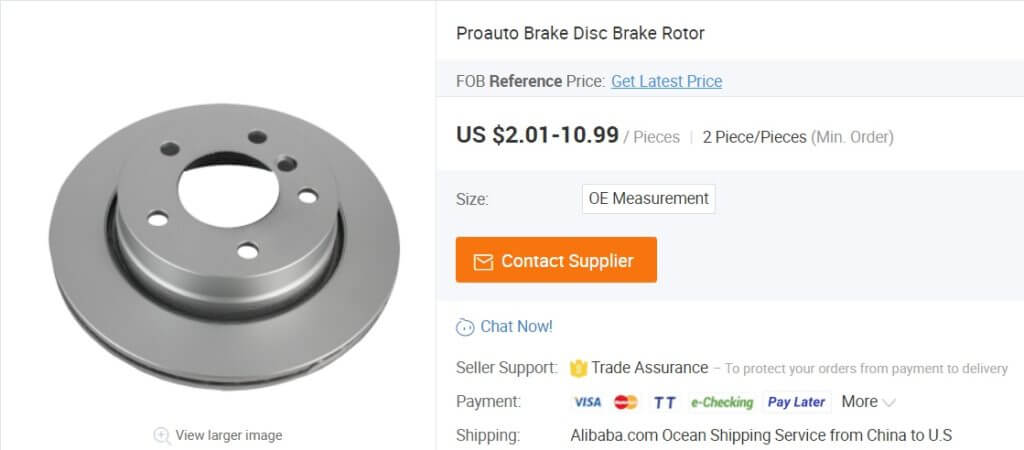
It looks almost like a more expensive rotor, so what’s really the difference quality-wise?
Cheap brake rotors are made with less metal
Here are two brake rotors for the same year, make, and model. But they don’t weigh the same. The OE quality brake rotor weighs 16.8 lbs., while the economy rotor weighs just 14.2 lbs. That’s 15.4% less metal. What does that mean in actual road use? It means it can’t dissipate heat as well as the premium rotor because it has less mass. And the excess heat will wear out your pads faster. But that’s not the only reason why economy rotors are bad.
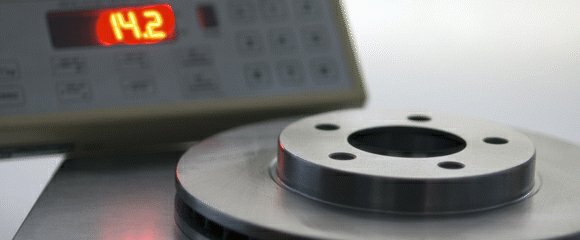
Economy Brake Rotor
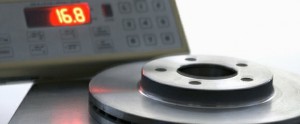
Premium Brake Rotor
Cheap rotors are thinner
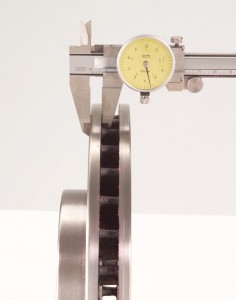
Economy Brake Rotor Friction Surface Thickness
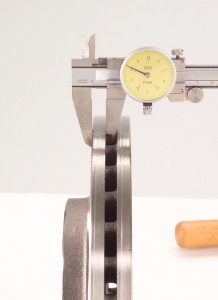
Premium Brake Rotor Friction Surface Thickness
Here we’re looking at the thickness of the friction ring. Look at them side-by-side, and you’ll see the economy rotor has a thinner friction ring.
Cheap rotors have fewer cooling vanes
What you can’t see in these photos is the total number of cooling fins. The economy rotor has fewer cooling vanes, so it doesn’t cool as effectively as the OE rotor.
Cheap brake rotors don’t have OE cooling vanes
Economy rotors usually don’t copy the OE cooling vane design because those designs are more costly to manufacture. To cool more effectively, carmakers use curved, pillar, and arcuate vane designs to force more air between the friction rings and improve braking.
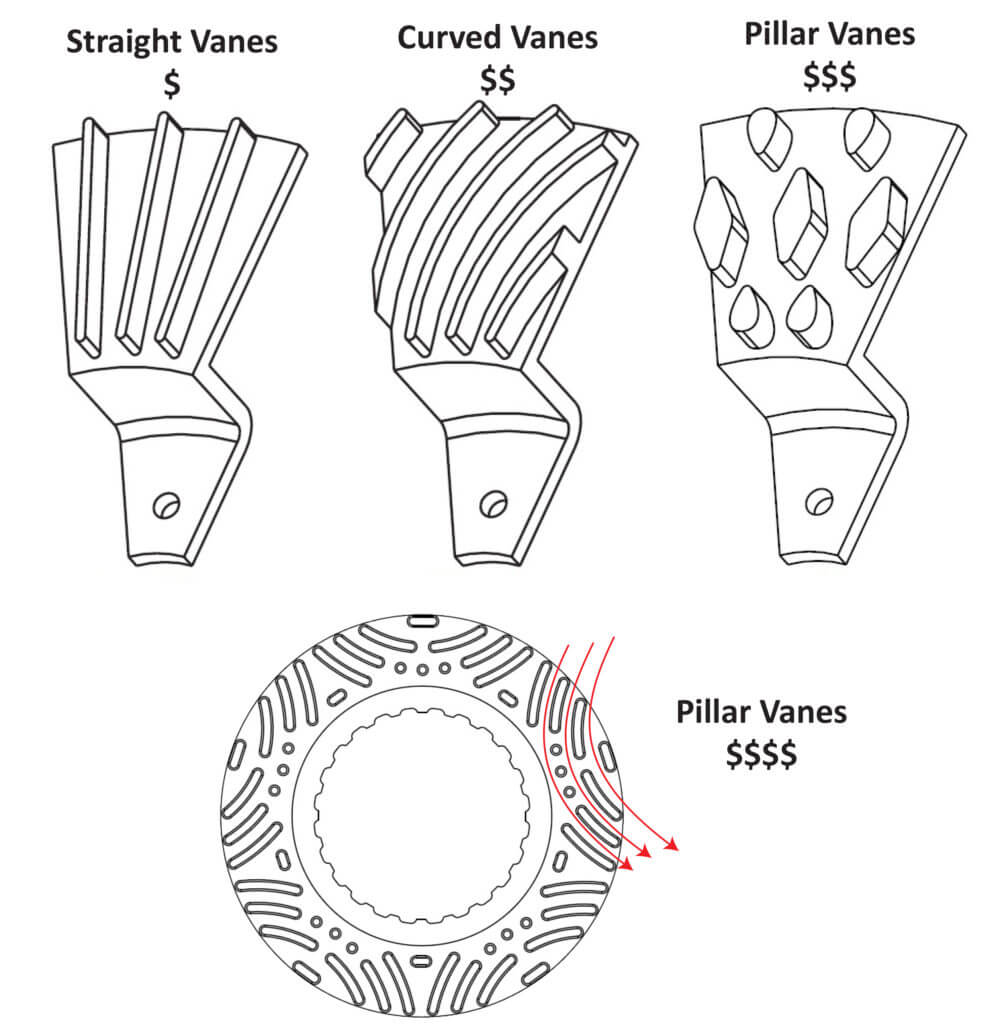
Brake rotor cooling vane designs from cheapest to most expensive
Economy rotors aren’t curved like the factory or premium aftermarket rotors. That diminishes cooling even more. Here’s the bottom line. Economy rotors won’t last as long as premium rotors and your stopping distance will increase due to the extra heat.
In fact, there are currently over 600 different cooling vane configurations for today’s cars. These exotic vane configurations are costly to reproduce, so many aftermarket rotor manufacturers simply build their rotors with the cheapest cooling vane configuration and the least expensive metallurgy. How would you possibly know if you didn’t get the same rotor as the original equipment? Well, your brakes won’t cool as well, so they’ll wear out faster. In other words, you won’t know until you realize that your brakes wore out faster than the factory brakes. By then it’s too late to do anything about it. That’s why it’s so important to demand high quality OE rotors from the shop. Ask the shop to show you the new rotors. If you have to, shine a flashlight into the air gap between the rotor plates to examine the cooling vanes.
Cheap brake rotors are made with cheaper raw materials.
The best brake rotors contain iron, graphite, silica, and pearlite, along with a higher percentage of damped carbon (3.6-3.9%) to increase hardness, reduce noise and improve braking performance. High carbon content also reduces “judder” vibration. Economy brake rotors usually have a lower carbon content, so they’re softer and easier to machine during the finishing step. Look for the casting grade in the description. Cheaper rotors are made from G1800 gray cast iron, while better rotors are made from higher carbon G3000 gray cast iron.
Cheap rotors are made on fast production lines
The cooling process is just as important as the mixing, heating, and casting process. Improper cooling creates stress in the cast rotor that can result in cracking when in use. In fact, premium brake rotors include a separate stress-relieving process that keeps the rotor at a constant 500° F for a longer period of time to ensure the microstructure contracts at a safe and predictable rate. That extra stress-relieving process takes time and consumes more energy, which raises the cost. Economy rotor manufacturers shorten the process, so they can sell their rotors for $2.
Cheap rotors often don’t have the proper non-directional surface
All carmakers recommend a
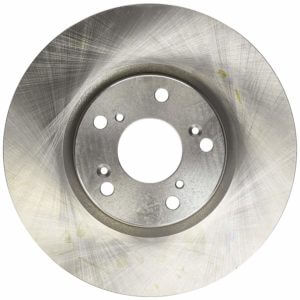
Brake rotor non-directional finish
60- to 80-microinch surface finish (smoothness) to ensure proper brake pad bedding and noise reduction. The non-directional surface lasts long enough to seat the pads properly. Premium rotors are ready to be installed after a quick cleaning and bedding, while economy rotors often need additional machining to achieve the recommended 50-microinch non-directional surface.
Cheap rotors rust faster
Cheap rotors are often coated with an oil film to protect against rust during shipping. However, some rotor manufacturers skip the oil and apply a phosphate finish. Don’t be fooled, that finish will wear off within weeks after installation.
Premium rotors are coated with a fused-on rust-reducing coating
Rust prevention isn’t needed on the swept area because the brake pads

Rust develops in the cooling vanes, dramatically reducing airflow and cooling
removes any rust accumulation. But rust coating is very important to reduce rust in the cooling vanes and the inside and outside the rotor hat areas. Rust expands as it forms, and that expansion can literally force the rotor away from the wheel hub, causing lateral run out which results in disc thickness variation.
Cheap rotors have less dimensional stability and balance
It takes time and effort to produce a dimensionally stable brake rotor batch after batch. Economy rotor manufacturers try to make up for dimensional instability by machining off the irregular areas. But that causes balance problems, which the manufacturer tries to solve by adding weights. Over time, those weights rust and fall off, causing an off-balance condition that mimics the feeling you get from an out-of-balance tire.
Cheap brake rotors are no bargain
The price difference between private-label economy brake rotors and premium brake rotors is usually only about 20% of the total parts cost. But a premium brake rotor can greatly extend the life of the brake job and is much more effective in reducing noise and pedal pulsation over its entire life.
© 2012 Rick Muscoplat
Posted on by Rick Muscoplat
